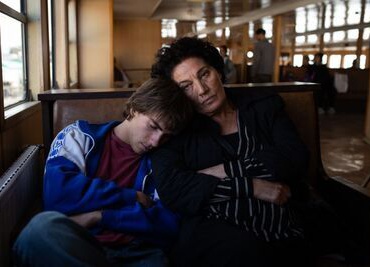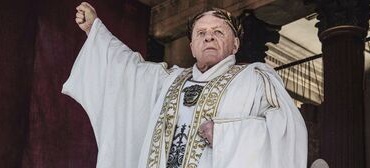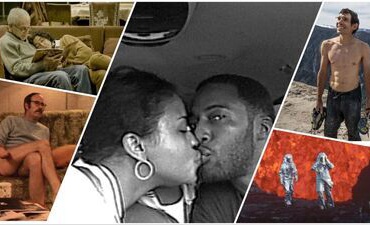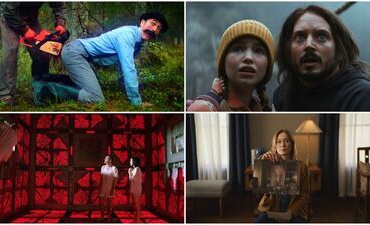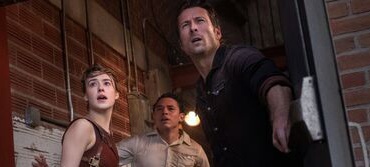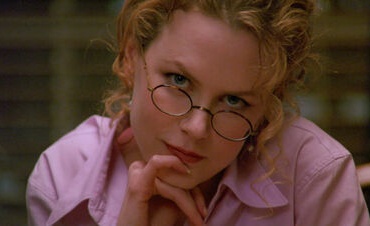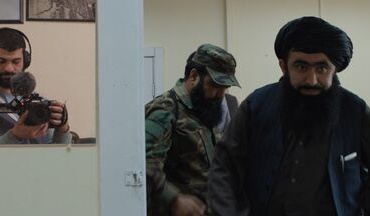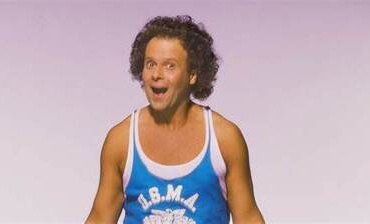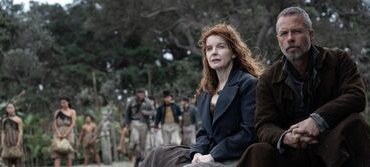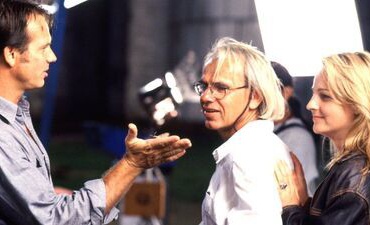
In the deeply felt new drama “Crossing,” a retired Georgian teacher named Lia (Mzia Arabuli) is on a mission. Her sister passed away recently, and at her deathbed, Lia promised that she would find the sister’s estranged daughter Tekla, a trans woman who was disowned by the family. Lia’s search takes her to the home of Achi (Lucas Kankava), a restless young man desperate to escape his own stifling family. Achi tells Lia that he knows Tekla—and that she crossed the border into Istanbul. He knows the address, so he asks Lia if he can accompany her on the journey. Without many options—and feeling guilty about how she and her family treated Tekla—Lia agrees.
Premiering at this year’s Berlin Film Festival, where it won the prestigious Teddy Award for outstanding queer cinema, “Crossing” (which opens Friday in select cities, landing on MUBI August 30) has the simplicity and street-level authenticity of Italian Neorealism. (Indeed, many of the supporting cast are nonactors.) And it demonstrates another step forward in the evolution of writer-director Levan Akin.

A Swedish filmmaker of Georgian descent, he grew up with parents who were born in Turkey, so the literal and existential border-crossing Lia experiences is not unfamiliar to the 44-year-old filmmaker. Interested in exploring sexuality—especially when it comes in conflict with close-minded cultures—Akin faced controversy with his previous film, 2019’s “And Then We Danced,” which was about homophobia in a Georgian dance troupe in which two male dancers fall in love. The production got death threats, and violent protests greeted the film’s release in Georgia—shocking for a film so lovely and gentle.
Akin has responded with another exceedingly delicate and thoughtful film. Running parallel to Lia and Achi’s search for Tekla within Istanbul’s trans community, “Crossing” also introduces us to Evrim (Deniz Dumanli), a trans woman who’s a lawyer who works for an NGO representing trans locals. Eventually, these two strands will intersect, but there’s nothing forced in this bittersweet film about regret, reconciliation, and aging.
Earlier this week, I talked to Akin over Zoom from Stockholm about “Crossing” and what inspired its wistful story. We also discussed how Madonna, “Anne of Green Gables” and Lestat helped shape him as a young gay man. (By the way, Madonna, if you’re reading this, you two almost met when he was 18—I’ll let him explain.)
You have said that “Crossing” was based on a story you heard about a Georgian grandfather who publicly supported his trans granddaughter—and that it made you wonder if your own grandparents would have done the same. Are they still with us? Were you making this movie for them?
They’re all dead. My grandfather was alive ‘til 2011, maybe? But all the other ones died when I was quite young. So I think these movies are very much an exploration of my place in the context that the films are set. “And Then We Danced” was very much “Who would I have been in Georgia?” There was a debate after “And Then We Danced” came out that was very polarizing in Georgia—“Oh, it’s the Soviet generation versus the post-Soviet generation”—and I felt that discourse was so basic and not true and that it can’t be that black-and-white. [The discourse] was so divisive—it just served the narrative of this pro-Russian, very conservative Christian group that is very, very loud, but they’re by no means the majority. So I felt very strongly that I wanted to make [my next] film from the point of view of an older relative to somebody who is LGBTQI+.
To answer your question, what would my grandmother have said? Would she understand? I think that’s what happens with Lia in the film—in the beginning, it’s like, “[I have to find] my niece, I promised her mother.” She’s almost like a Wild West figure: “I’m on a mission. It has nothing to do with me, really. It’s just something I’m doing for her mother. I’m very closed off. I’m going to do this because I have to honor my sister, and then I’m done.” [Achi] asks her at some point, “What are you going to do in the future?” And she’s like, “What are you talking about? I have no future. I’m just going to die.” When I did “And Then We Danced,” it’s all anecdotal, but a lot of stories came out from there where people in the film team would take their parents, who were homophobic by default. But when they saw the film, and when they placed it in a context—there’s a face, he has a home, he has a grandmother, he’s not this alien figure—they [said], “[He’s] like one of us.” I also wanted to do that with this film: If [Lia] is presented with this world, will she continue to stay half-bigoted, or will she evolve?
Your film advocates for trans individuals, but it also reminds viewers not to be prejudiced against older people, who may not be as antiquated in their thinking as we might assume.
Lia is based on many older people I’ve had around me growing up—women specifically. In Sweden, it’s very age-segregated—here, if somebody’s old, you’re like, “Oh my god, they’re old,” and you don’t really interact. I do, but if you go to a club or a bar here, it’s not mixed like in Turkey and Georgia. Here, old people are just expected to wither away somewhere alone—you don’t want to see the process of aging. I grew up a lot around older people because I have a different heritage.
I have always been very fond of history and listening to the stories of older people. I was the little kid who always sat in one woman’s lap while all the other women talked and drank tea. I felt more safe there than in the male rooms and spaces—probably because I was gay, but I didn’t think about it then. Something was threatening to me in the air in this patriarchal system—I’ve always shied away from it.
Also, growing up, I was always very fond of these older characters that grew a heart of gold. In Sweden, we only had two channels in the ‘80s before cable came, and then they had this Canadian show, “Anne of Green Gables.”—I fell in love with Marilla; she was my favorite. I love that actress Colleen Dewhurst—I’ve looked her up since, but I didn’t know she was dead. She was just so good. I’ve always been very drawn to that type of person, so I’m so happy that Lia exists now in my filmography—she was always supposed to be there.

Because of the death threats you got for “And Then We Danced,” were you worried going into making “Crossing”?
I wasn’t worried, actually. My producer Mathilde Dedye, who I worked very closely with, took precautions just in case, but Georgia is a very safe country, and the people are very, very open. Those people who were yelling the loudest [about “And Then We Danced”] are a small minority, and they probably don’t even remember my name.
With this movie, as soon as it came out in Berlin, they started writing disparaging pieces about it in the media and calling it all sorts of crazy stuff. We did a very conscious thing then—we pulled it from being screened in Georgia, because we didn’t want it to be used in this political way. We will screen it at some point, but we’ll see how we do it.
“Crossing” isn’t meant to be a documentary, but you spent a lot of time researching the trans community in Istanbul. Research was also central to your script development in “And Then We Danced.” It seems you’re very invested in understanding the worlds you chronicle.
I directed a lot when I was younger in Sweden—I did a lot of TV and things like that—and one day I was like, “Wait a minute, this is just a job. What’s the point? I can’t just be a director. I want to do something that feels more meaningful with my time.” So the idea of every step of the process being interesting to me personally—where I learn new things and see new things—has been a driving force in my filmmaking. And then what happens, inevitably, is that I meet people, I see specific things that I want to share with an audience or that I want to capture.
I’ve also always been very obsessed with the notion of time and things getting lost in time. When I was a kid, my father had old Georgian films on VHS, and we watched them. Also, the Neorealists—Pasolini, Fellini—they’re capturing an essence almost. Like a movement, like a spark. That’s what I wanted to do with both “And Then We Danced” and this film—to be able to do that, I have to spend time there and be in those places.
Istanbul is such a transient place. It’s always changing, people are changing—it never stays the same. So even though I went to Istanbul as a kid, it’s a different place from the one I now encounter as an adult. And all of the people that you see in the film—everyone except Lia, the two policemen and the taxi drivers—all of the rest are real people. You find them, and they’re so interesting and funny and smart and witty. When I met them, I was like, “My god, they have to be in a movie. We need to see it. People need to know these women.”
In that research, were there things you learned about Istanbul’s trans community that didn’t fit in the final film?
You know how it is: You start wide, then hone in, and we started very wide. We started with meeting these NGOs: Pink Life, which is in the film, and Red Umbrella, which is doing a fantastic job with trans rights in Ankara. Then I would meet people working there—I [found] such optimism and resilience, which I wanted to show in the film. A lot of the things that I did see and experience made it into the film—of course, not everything, but like the woman at the end where you find out [spoiler redacted], that’s a recreation, but I was in a very similar space having very similar type of dialogue with a woman. It is very cinéma vérité.
I would’ve loved to make an even longer movie about Evrim on her own, just fighting injustice in Istanbul—that would be so much fun. But these movies are so hard to make—you have to finance them and it takes a long time. “And Then We Danced,” I didn’t get almost any money to make that film—we applied to all the funds and applied here at the Swedish Film Institute, and the guy in charge then said, “This is not interesting. Nobody’s going to care.” I think he had it out for me—he’s never been nice to me—so he didn’t give us any money. So then we went through the documentary section, and [they] loved the stuff that I’d filmed, so it’s thanks to them that we got the ball rolling—I think we shot that movie for 300,000 Euros.
When I did this film, I got a little more money to make it, but it’s still a big puzzle—this Euro financing thing is crazy. I’m going to continue making films, but I’m starting to also be like, “How can I navigate this in a way where maybe I can work faster?” Because this was like five years. [laughs] I don’t know, now you’re getting my inner monologue.
In terms of getting financing, does it help that “Crossing” has a very traditional narrative? Basically, it’s about two people on a road trip trying to find someone.
“And Then We Danced” is also a very classical narrative. That’s been the saving grace for both of these films—this one is maybe a little more free-flowing, and I could afford [to do] that after “And Then We Danced,” but you need to hook the viewer. What do people take away from [“Crossing”]? They don’t take away, “Oh, how interesting to be educated about trans life in Istanbul.” No, they take away lovely characters they fall in love with and a story that activates the viewer—that’s what they need. So I have to apply this more capitalist, Western type of storytelling that’s more rewarding to the viewer.
If I would’ve done [“Crossing”] more, I don’t know, slow cinema or whatever you want to call it … you can feel those tendencies in my film, there is a yearning to go there more, but I would never be able to finance them. Well, I could finance it—I could make them maybe cheaper. You can always make a movie, but I don’t think they would reach an audience. [No] Georgian film has had the life that “And Then We Danced” had, not before or after. And I think this one is now being released in even more countries than “And Then We Danced,” which is exceptional for a movie from that region.
If money was no object, what would your movies look like?
I know exactly what I want to keep doing, and it is films like I’m doing. I know precisely what my next film is going to be and what it’s going to be about. I know what I want—I want people to connect with these characters and these worlds. I want people to enter spaces they haven’t been in before and just be immersed in it. Because that’s what I love, myself, in cinema. It’s like traveling—it’s so fun.
Have you talked about what your next film will be?
I haven’t. I’m still in the process of writing and exploring it. I know what the main narrative is, but I’m still figuring things out. I wish I could talk about it.
At this stage of writing, are you sharing the idea with anyone? Or do you not like talking about it before it’s done?
I share it with close friends to get feedback. In this case, I have a commissioner to whom I pitched the idea. They said, “Oh, that’s super-interesting. Here is a little money so you can do research and explore it.” That’s usually how it starts, and then I spend time exploring and doing research. Then I write a script—if people like it, the ball is rolling.
I have writer friends who go so far down the rabbit hole of researching that it can be hard for them to let that process go and do the writing. Do you struggle with that?
I’m very efficient because I do everything at the same time. I have almost an outline of what I want the story to be, and then I do very specific research and conversations to see if it’s realistic. I can go meet a person and then go home and write a whole scene; some of it makes it into the movie. So, it all flows into each other.
In interviews like this one, you’ve said that Istanbul has changed so much since you were there as a boy. But how has it changed? Is it simply a bigger city?
So many things. Yes, it’s gotten much bigger—the population has grown super-much since I was there. However, it also feels more diverse because when the Turkish Republic was formed, it became more forced and homogenous in Turkey. Now, it feels like there are much more Syrians, a lot of refugees. And a lot of queer people from the region—Dagestan, Kazakhstan, Iran. Istanbul is a hub for people where you can go and live your truth, but also hopefully find a job or a living. But, yeah, it’s very alive, and it feels much more Western now than it did when I was a kid—[it has] so many American places that we don’t even have here. They have, of course, Starbucks. Do you know that Starbucks failed in Sweden? Isn’t that interesting? We only have one left. Nobody wanted to go there.
Your parents were born in Turkey but lived in Georgia. You were born in Sweden and have ties to all three countries. “Crossing” is partly about finding one’s true home: What feels like home for you?
I don’t really feel at home anywhere, unfortunately, which is very sad. I mean, I don’t know—maybe it’s not sad. In Sweden, when you’re dark, they will always be like, “Where are you from actually?” And I’m like, “I was born here and I’m Swedish.” But you’re never Swedish here—you’re made to feel that you’re not. If I was a Turkish person with blue eyes and blond hair, which they have in Turkey, then it would probably have been easier for me here. Also, I have a “weird” name for them in Sweden. And then in Turkey, I’ve never felt [at home]—and the same in Georgia.
Weirdly enough, I’ve always felt most at home when I’ve been in America or even England. It’s much more multicultural and diverse—nobody ever asks where you’re from. All of these countries have a problem with racism, of course—we know that—but I’m more “white-passing” in America than I am in Sweden.
You said earlier that making movies is like traveling—it made me wonder if you feel that way because you yourself don’t feel rooted in any one place.
I have a base, but maybe not necessarily a home. Also, my father was in the traveling business, so since I was a baby, I was always traveling to places with my dad. I’ve traveled my whole life.
Did you enjoy that as a kid?
He also wanted to move all the time—we moved every three months, he was crazy in many ways. [laughs] I remember I was like, “Oh, it would be nice to stay put,” but he was very restless. The travels, I enjoyed—and looking back now, I’m very happy, because we used to spend two weeks in Georgia in the summer, and that was during Soviet times. I’ve been in so many interesting places that are now history thanks to my dad.

You also direct episodes of “Interview With the Vampire.” Is that a nice contrast to the more low-budget films you make on your own?
I started my career working for TV in Sweden, and I started on some soap operas when I was in my 20s. Then I did bigger and better shows and this sci-fi show called “Real Humans” that was super-big-budget here. So I have experience with genre and bigger-budget things.
[“Interview With the Vampire”] is not so different to me—I’m used to that environment, and I can run that type of set. But it was very important that it was something that I felt very connected to. Also, making [my] types of films can be a heavy burden—it’s me and my producer Mathilde, and it’s just us, and we don’t have any resources. We don’t have any safety net, nothing. So to step into a world like “Interview With the Vampire,” where someone like Rolin Jones with such good taste has set it up, and you get to just walk in, do your thing, and then walk out, I think that’s so luxurious.
I used to love those [Anne Rice] books growing up. My librarian gave The Vampire Lestat to me when I was 15, which changed my life. The way she wrote about these people and how everything was possible, the world laid at their feet, opened up the world to me in terms of “What can I do?” Yeah, it was very pivotal to me.
What prompted her to give that book to you?
I had seen the movie, and I remember I was talking to her about it, but I think she also understood that I was probably gay, so she was like, “You need to read this book.” Also, I’d never read anything mainstream—this was the ‘90s, those were big books, [Rice] was like Stephen King back then. I love that she’s getting a resurrection now with this show. So for me to be like, “Oh, wow, this was a movie with Tom Cruise and Brad Pitt, and it’s super-queer,” that was really also self-acceptance. Self-acceptance was very important.
A lot of straight people, back in the ‘90s when the movie came out, didn’t recognize its queer subtext. We just thought it was a vampire movie with big stars.
It is very queer when you watch the film. I wish they would’ve gone all-out gay with it.
In your recent interview with The Guardian, you also talked about how important “Madonna: Truth or Dare” was for you as an impressionable kid—seeing two men kiss in a mainstream movie.
Had you seen that ever at that age? [Back then it was] Michael Jackson, Prince, Madonna—that movie was a game-changer. She sped that thing up so much by having that movie. It’s incredible what she did.
Have you ever gotten to meet Madonna to let her know how pivotal that moment was for you?
Funny story. So when I was 18, I studied at the Neighborhood Playhouse in New York—I studied Meisner technique. And then they had the VH1 Fashion Awards, and they hired kids from the school to be seat-fillers—they paid $100 or something, we thought it was so good. We were also supposed to be there for the rehearsals, so then me and my friends snuck in when Madonna was rehearsing “The Power of Good-Bye.” I remember that she was playing around and singing “Believe” by Cher when she was rehearsing, which I thought was pretty cool.
So, then, she was just sitting at the edge of the stage with, I think, her nanny and her daughter. Me and my friend walked [toward her]. I was going to go up to her and just say hi, but then as I came close—I was 18—I just chickened out and just took her in. What does she look like? How is her face up close? And then I just did a beeline off. So I never talked to her, but I was very close.
Have you forgiven yourself for chickening out?
I forgave myself. For me, it was just super-cool. I mean, what was I going to say? I was an 18-year-old kid: “Hi, Madonna!” It was never going to lead to anything. But, yeah, to even be in that context—I was a kid from Sweden who went with my friend to New York. We took a student loan from here to study—and then, two months later, we were seeing Madonna up close. To us, that was enough.


